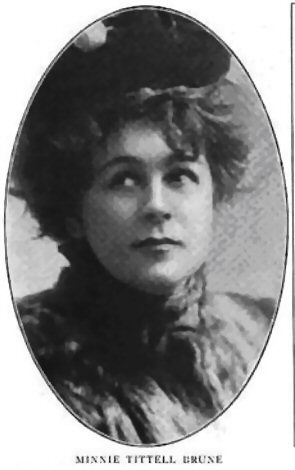
| Minnie Tittel Brune
(1875-1974) |

Ze speelde in drama-, pantomime- en
Shakespeare
producties.
Minnie werd geboren in 1875 geboren in San Francisco
Californië. Haar moeder Minna Esther St Marie was pensionhoudster.
Al
op haar
vierde jaar stond zij op het toneel in de rol van Little Jim in Lights
of
London in het Californian theatre.
Haar familie was streng katholiek en stonden niet achter
haar theaterambities. Opmerkelijk
was
dat Minnie en haar twee zussen kozen voor een theatercarrière.
Minnie ging een jaar naar een kloosterschool, maar het
theater lonkte. Zij maakte een tournee met Charles Frohman en stond op
het
toneel in New York in ‘The Girl I left Behind’. In 1899 trouwde zij met
Clarence
Brune, een advocaat die in de staat Washington herhaaldelijk in verband
werd
gebracht met landspeculatie fraude en schandalen. Mede in verband
hiermee
besloten Minnie en Brune te emigreren naar Australië.
Hun aankomst in juni 1904 verliep niet helemaal vlekkeloos: het schip waarop zij zaten liep in de haven van Port Phillip Bay aan de grond, maar Minnie bleef ongedeerd. Op 21 juli 1904 trad zij in Australië voor het eerst op in het Her Majesty’s Theatre en al snel veroverde zij de harten van het publiek en kreeg zij in de kritieken veel lof.
Door haar streng
katholieke
opvoeding was Minnie streng gelovig wat haar in conflict bracht met de
rollen
die zij speelde.
It is recorded that she appeared with her husband Clarence
(whose name she took) in a revival of Sardou's Theodora at the Grand
Opera
House, New York in 1901 and they toured together continuously in the
United
States for nearly a decade before leaving for Australia in 1904. But
it was
only in the Antipodes that she made a huge name for herself.
Australia 1904-1909
She was brought to Australia by J. C. Williamson, who is
said to have met her while she was on her honeymoon in Europe. It was
not until
1904 that he persuaded Minnie to voyage from California to Australia.
The ship
on which she and her husband travelled, The Australia, ran aground in
Port
Phillip Bay in June 1904. Minnie was unhurt, but she took a
philosophical view
of such incidents. She later told an interviewer "I was not alarmed
about
the wreck, though I fully realised the danger of it. If it was to have
been
that I should be drowned - well, that’s all about it. It would have
happened
so. As it was ordained otherwise, here I am!"
She made her first appearance in Sydney on Saturday
September 21, 1904, in the play Sunday, a Story of Western Life at Her
Majesty's Theatre. Minnie played Sunday, "the whole-hearted lovable
girl
at a miners camp." She was supported by Roy Redgrave and Gaston
Mervale.
The performance was a huge success, and led to her becoming one of the
most
popular actresses on the Australian and New Zealand stage. She received
lyrical
reviews for her performance as "Peter Pan" in the play's first season
in Australia in 1908, produced by J. C. Williamson. She was by then 29
years of
age and a devout Catholic, a non-smoker and teetotaller, and often
quoted the
Bible in press interviews. One magazine quoted her as saying:
Later career
Minnie Tittell Brune’s five year sojourn in Australia ended
in 1909. She decided to try her luck in London, but met with limited
success.
She received only mediocre reviews in her first piece, The Eternal
Question at
the Garrick Theatre. Her work in 1910 included Dr Jekyll and Mr Hyde at
the
Queen's Theatre opposite H.B. Irving, Sir Henry Irving's surviving son,
and as
chorus in Henry V.
Minnie had few London appearances in 1911, her major role
being in a play called The Woman on the Case at the Coronet theatre.
The New
York Times reported in August, in addition to a report that ostrich
feathers
were making a comeback, that she had returned on the Oceanic after an
absence
of nine years to appear in New York, billed as Minnie Tittell-Brune at
the Manhattan
Opera House in An Aztec Romance. By 1913 she was back in London where,
during
her stay, she made three movies under the name Fanny Tittell-Brune:
Esther
Redeemed (1915), Iron Justice (1916), and Temptation's Hour (1916). In
1916,
Minnie was also credited as being in six other films directed by Hal
Roach,
starring Harold Lloyd. In 1917 she was singing at London's Coliseum,
before she
returned to her home country.
Nothing further is known of her career. She became widowed
when her husband Clarence died in 1935, and was living in obscurity as
a member
of the Order of St Francis when she died in her 100th year in Los
Angeles in
September 1974. She was interred with a Catholic service.
Little noticed in her own country, and lacking even a press
obituary, she was nevertheless a major figure in the history of the
Australian
stage where, for a period, she had been a household name in both
Australia and
in New Zealand.
| Als je
een aanvulling of opmerking hebt over deze site dan kun je een
mailtje sturen naar Transarchief |